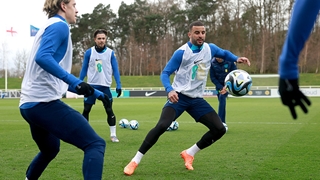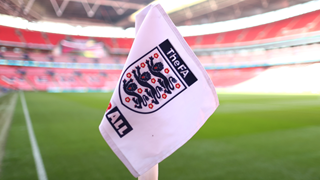
The spectacular scale of St. George’s Park provides visitors, old and new, with a sense of excitement throughout their stay.
From the moment you drive through the gates of the National Football Centre in Staffordshire, you’re met with rolling fields, stunning countryside, a variety of beautiful plants and flowers, before your eyes meet the first of 14 pristine pitches utilised by sports teams at all levels.
Andy Gray is St. George’s Park’s Head of Grounds and Estates, joining from Southampton three years ago after spending 22 years on the south coast.
Overseeing a team of 19 grounds staff, it is Andy’s responsibility to not only ensure that the playing surfaces employed by attending teams are at the highest possible level, but to also ensure that the aesthetic of the 330-acre site means that each and every visitor is left in awe.
During a busy time for Andy and his team, the close-season provides a perfect opportunity to understand Andy, and his team’s, role in meeting the challenges faced to ensure St. George’s Park maintains its excellent reputation within elite football and sport in general. In this feature, Andy outlines his team’s responsibilities and provides insight into how the site’s playing surfaces are maintained…
What does your role as Head of Grounds and Estates entail?
Simply put, I usually say to people that if it’s outside and it’s green, it’s my responsibility. We, The FA, own the site which is 330 acres, and within that is what I call an ‘inner fenced area’ of about 120 acres, which is what I equate to the day-to-day maintained area. 10 full-sized grass pitches and the areas around them, such as the banks, fields, trees, shrubs and plants; this is what makes up the day-to-day maintained area. The other 210 acres is farmland, which is rented out to a land agent who raises their cattle. You often see the cattle as you drive in and I don’t know of anywhere else where you could see that and then suddenly see a state-of-the-art football pitch, then a hotel, then the football centre and the other pitches. There’s nowhere else like it and I think that makes St. George’s Park so special.
How many people make up your team?
Looking after the maintained area, including myself, we have 19 people. To break that down further, one of the team is employed by Hilton to look after the hotel grounds; however, they’ll utilise our equipment and will be directed by us as to what to do and when to ideally do it. Matt Arnold is my Deputy Head of Estates, and he is one of four full-time FA employees. In terms of grounds staff, we have 10 full-time grounds, headed up by Dan Oliver who is my Deputy Head of Grounds. With a grounds apprentice, we have 11. We then have two fixed term summer employees, contracted for four months that support us during that time
Is there such a thing as an ‘average day’ maintaining St. George’s Park? If so, what does that look like?
There is and there isn’t such a thing. As we speak, we had the senior men in last week and the senior women in this week and next. They use the same pitch (the Bobby Charlton Pitch), so there is a daily schedule for that. If they’re not in, then the daily schedule is very different. We split the park into three; front, middle and back. Within the grounds team, we’ll have three people in each area and Dan oversees it all. General maintenance will include cutting and, if the pitches are being used, we do something called cleaning up. That hoovers up the debris that’s been kicked up during a session or match. You’d usually see that at most Premier League grounds after the game. Every week, there is something going onto the pitches, whether that’s granular feed or a liquid feed. There are two different types of each feed for both the soil and the plant. Marking-wise, we’ll obviously mark the pitches if they’re in use, but we also try and keep the lines in on the pitches not in use. It helps ensure there’s guides for when we do mark them fresh, but also it just looks nice! Cutting, cleaning, feeding. They’re three things that regularly take place.
How do the pitches differ, and do any bear similarities to the Wembley playing surface?
The Bobby Charlton Pitch is exactly the same size and composition as Wembley. Pitch 5 is the same, apart from its two metres thinner because of the floodlight towers. Pitch 4 is the same dimensions as Wembley, but not the same composition. All of the pitches are hybrid, but the difference between the Bobby Charlton Pitch and Pitch 4, I say it’s like separating Coke and Pepsi. Pitches 8, 9, 10, 11 and 12 are natural soil with no reinforcement whatsoever, and Pitches 1 and 3 at the front of the park are fibre sand, which is a sand-based pitch with a mid-layer pitch construction.
Do you have much dialogue with the Wembley grounds team?
So, coincidentally, Karl Stanley who is the Head Groundsman at Wembley used to work at Southampton. I’ve known Karl for at least 20 years, so we speak as much as friends as we do as colleagues. We talk, but he’s got his pitch inside a concrete building inside the centre of London, which has to host football, rugby, American football, boxing and everything else. We have 10 grass pitches in the open-air countryside of Staffordshire. It’s tough to compare maintenance procedure to both, but when we have the seniors, we do keep the dimensions and grass length the same, we use the same equipment. The main thing we can manage is the hardness of the pitch, which we monitor.
In part two of our discussion with Andy, he reveals the close relationship he has with England’s physiotherapy and sports science team, work around the 10 pitches at St. George’s Park and how off-season maintenance is carried out.
Check back soon for part two of our interview with Andy.











